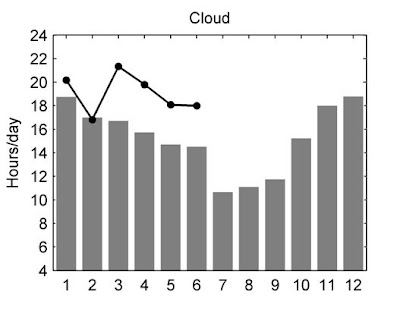Today will remain dry, but there is a good chance it will rain tomorrow (Sunday)!--more on that later.
Before I talk about tomorrow, I wanted to show another fascinating figure on our cloudiness issue this year, produced by Dr. Jim Johnstone (Dr. Fog), who I mentioned in my last blog. Beware! This is one hell of a depressing figure.
The grey bars show the average number of hours of cloudiness at Sea-Tac Airport per month (1=January, 12=December). 18-19 hours a day in midwinter, with a gradual reduction to about 15 in June. Then a HUGE decrease to around 11 in July, a graduate increase through September, and a jump up in October. All locals know about this pattern--we have three months of relatively bountiful sun: July through September.
But now the depressing part. The black line shows this year. You will notice that we have maintained wintertime cloud levels through June. And I guarantee you that when July numbers get plotted in a few days, we will be way above normal (probably 15-16). This figure, more than any other, expresses the unhappy moods of so many.
But yesterday was simply spectacular and today will be the same. I was on the East Coast last week and experienced 103F with dew points in the mid to upper 70s. Personally, I would rather have the cooler, milder weather.
This morning some low clouds along the coast pushed in through the Strait and Chehalis Gap...but are rapidly burning off as I write this (see image).
Tomorrow, a weak front will move in--pushing a surge of marine air into the west and to the Cascade crest. Here is the predicted 24-h precipitation ending 5 PM tomorrow.
The windward side of the Cascades will be a soggy place to hike and conditions will deteriorate rapidly going into BC. So go south and east for better conditions. Low clouds will spread over the west. But improvement beckons on Monday...







Hey Cliff, love the blog, but here's a question for you: For somebody who preaches about the uncertainties in weather prediction, how come you rarely plot them in the graphs you show? I especially wondered that relative to today's "cloudiness" plot -- how big are the error bars on the averages? Are we outside of normal this year, or just relatively high? Error envelopes are my favorite way to show uncertainties, since they allow you to easily intuit whether two ranges are really different. E.g., http://bit.ly/oIVmUI . Just a thought!
ReplyDeleteThere are substantial differences between the separate concepts of uncertainty in prediction, and uncertainty in measurement.
ReplyDeleteI'm guessing Prof. Mass doesn't show margin of error on his graphs of observed data because they 1) are already accounted for in models used for forecasting, and b) aren't very interesting, particularly in charts that average many observations together.
What amount of sky coverage constitutes "cloudy" for Dr. Fog's data? Broken? Overcast? >= n Octas?
ReplyDeleteGiven that Dr. Fog is using data "at Sea-Tac Airport", I think it's safe to assume that they're taken from METAR observations, and given that, I'd assume he's tallying up hourly reports that have at least one OVC, BKN, VV, CU, or CB component.
ReplyDeleteHe might be counting SCT and even FEW as well, but it wouldn't matter much, given that the purpose of the chart is to compare the current year to averages of previous years.
I like the site as well. Still, you say that you would rather have this milder summer than you saw in the East when you were back there. Well, I agree with that, BUT the problem is having this huge cloud cover and/or rain for so long out of the year. It makes the climate here pretty much unbearable for a transplant like me. Now, the normal PNW response I get is to get the hell out of here if I don't like it. Well, I guess I have taken that advice. We have a time-share in So.Cal. where we used to live, so while the locals here in the Podunkland, Oregon area are saying that they are close to 21 days without rain, I am now over 60 since I left and returned. The PNW is normally known for very nice summers, but the last two years have been ridiculous. I have had to resort to leaving in order to get our summers. C'est la vie, I suppose.
ReplyDelete